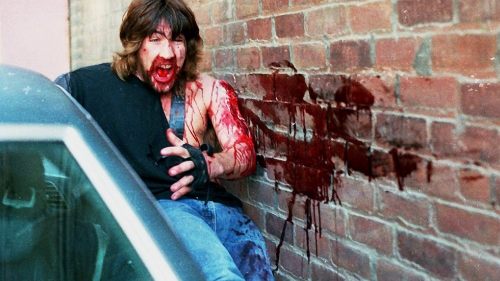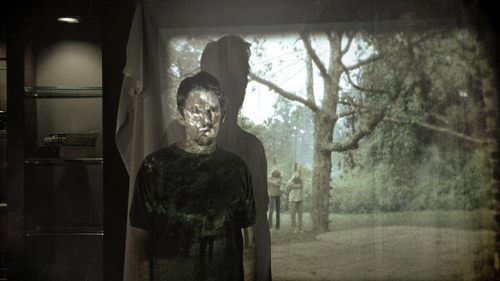The Savage Stack - HOUSE ON THE EDGE OF THE PARK (1980)
There’s always going to be – for lack of a better term – a stack of films we’ve been meaning to get to. Whether it’s a pile of DVDs and Blu-rays haphazardly amassed atop our television stands, or a seemingly endless digital queue on our respective streaming accounts, there’s simply more movies than time to watch them. This column is here to make that problem worse. Ostensibly an extension of Everybody’s Into Weirdness (may that series rest in peace), The Savage Stack is a compilation of the odd and magnificent motion pictures you probably should be watching instead of popping in The Avengers for the 2,000th time. Not that there’s anything wrong with filmic “comfort food” (God knows we all have titles we frequently return to when we crave that warm and fuzzy feeling), but if you love movies, you should never stop searching for the next title that’s going to make your “To Watch” list that much more insurmountable. Some will be favorites, others oddities, with esoteric eccentricities thrown in for good measure. All in all, a mountain of movies to conquer.
The seventy-fifth entry into this unbroken backlog is Ruggero Deodato's depraved Italian cousin to Wes Craven's Last House On the Left ('72), House On the Edge of the Park...

David Hess was a rock and roll musician, but he always wanted to be an actor. When Last House On the Left ('72) was originally being developed as a hardcore roughie – with smut producer Sean S. Cunningham and his X-rated cutter Wes Craven looking to cash in on a budding 42nd Street horror market – Hess was still committed. He didn't care that he'd have to take off his clothes and engage in unsimulated sex. For him, it was a potential break out moment, a means for the second fiddle player (who even penned "All Shook Up" for Elvis Presley) to see his mug on the big screen and become the star he always wanted to be.
Unfortunately for Hess, even though Craven's Last House would go on to be heralded as one of the seminal scare pictures from the '70s – a savage howl of disgruntlement that preceded Tobe Hooper's equally angry Vietnam scream, The Texas Chain Saw Massacre ('74) – the starry-eyed exploitation actor had trouble landing work after his debut was released. Producers often believed that Cunningham and Craven had simply cast a madman off the streets of NYC and let him loose onscreen, raping and killing at will. It was a testament to Hess' intensity that his legendary sexual fiend Krug (whose name would go on to influence another one of Craven's perverted maniacs in '84) scared the shit out of even the moneymen looking to finance further repellent pictures. They confused the performer with his character, an assessment Hess would later concede in interviews wasn't too far off the mark at the time.
So, Hess followed in the footsteps of many B-Grade actors during his day and migrated to Europe, where he found work in numerous gialli and Italoschlock pictures such as Hitch-Hike ('77), squaring off against Franco Nero and Corinne Cléry in the middle of the Campo Imperatore. Seeing how production and ethical standards in Italian shock cinema were often significantly lower than their American counterparts, Hess' brand of mental patient sexual aggressiveness was acceptable, his terrifying tantrums becoming commonplace in these poorly dubbed filmic exports. Hess combined the carnal prowess of a XXX star with the wildman unpredictability of a true character actor. He was the type of man you never wanted to encounter on the street, because he'd probably cut you with his blade before having his way with your girlfriend.
Craven invited Hess back to the States to appear as one of Anton Arcane's (Louis Jourdan) paramilitary thugs in his big screen Swamp Thing ('82) adaptation, but before the songsmith-turned-thug headed home, he delivered what may be his most terrifying turn in Ruggero Deodato's House On the Edge of the Park ('80). With this stomach-turning atrocity exhibition, the Cannibal Holocaust ('79) director applies his anti-human tendencies to a perversion of Last House (right down to the cash-in title), all while attempting to smuggle in some rather lunkheaded commentary regarding class warfare and capitalism. Yet the real reason to watch the movie is Hess, who essentially rolls all his sexual destruction into one hellish terrorist, wielding a straight razor as he rapes a disco bimbette (the actor’s own wife, Karoline Mardeck) before the opening credits roll.
The narrative of House On the Edge of the Park – if such a threadbare stringing of events can even be labeled "storytelling" – revolves around Hess and "John Morghen" (a/k/a Giovanni Lombardo Radice, from Umberto Lenzi's equally nauseating Cannibal Ferox ['81]) playing parking garage attendants who invade a bougie party. Of course, Hess has control over Morghen's simple-minded fool, warning him that the upper crust guests at this soiree are simply laughing at his dance moves, and that none of the women here would ever sleep with a couple of low rent grease monkeys. In retaliation, Hess crawls into a shower with soapy softcore star Annie Belle (of Jean Rollin's Lips of Blood ['75]), before ordering his lackey to penetrate another reveler (Lorraine De Selle) in front of the whole gathering. It's a sadistic display of carnality that would make the Marquis de Sade wince, as Hess tosses off racial epithets before smashing the face of a "fag" (Christian Borromeo) in cold blood.
Deodato should've arguably been kept as far away from a movie camera as humanly possible. Look up any interview with the cast members from his numerous “cannibal vomitorium” entries (to quote the great Bill Landis), and you'll find first-hand accounts of an artist who put his actors, crew and even extras through absolute hell. Some even claimed that Deodato actively volunteered and enjoyed being the one who enacted the numerous instances of onscreen animal cruelty his pictures contain. Though House On the Edge of the Park doesn't include any turtle dismemberment, the active misogyny and disregard for humanity come off like a mutant fetishist's wet dream. However, for all the disreputable and despicable behavior on display, Deodato was one of the most technically proficient of his country's workmen, framing these tableaus of torture like they were the fucking Mona Lisa, scored by Riz Ortolani’s beautiful lullabies.
Hess would never reach the morally reprehensible heights of House On the Edge of the Park ever again, and that's certainly for the best. During the '80s, Hess spent the majority of his time playing heavies on Knight Rider and The A-Team, while occasionally reteaming with his Italian brethren to try and gross us out yet again (see: Deodato's mid-wave camping slasher, Body Count ['86]). Hess even helmed his own horror picture – the criminally underrated holiday dead teenager romp To All A Goodnight ['80]) – yet it was a confluence of era, lack of principled core, and the actor's distinct screen presence that graced genre devotees with one of the greatest career villains of all time. It feels weird to praise a guy for consistently portraying a convincing rapist, but David Hess owned that specific strain of insanity in spades, and exploitation cinema was never the same afterward.
House On the Edge of the Park is available now on a double feature Blu-ray from Kino Lorber.



